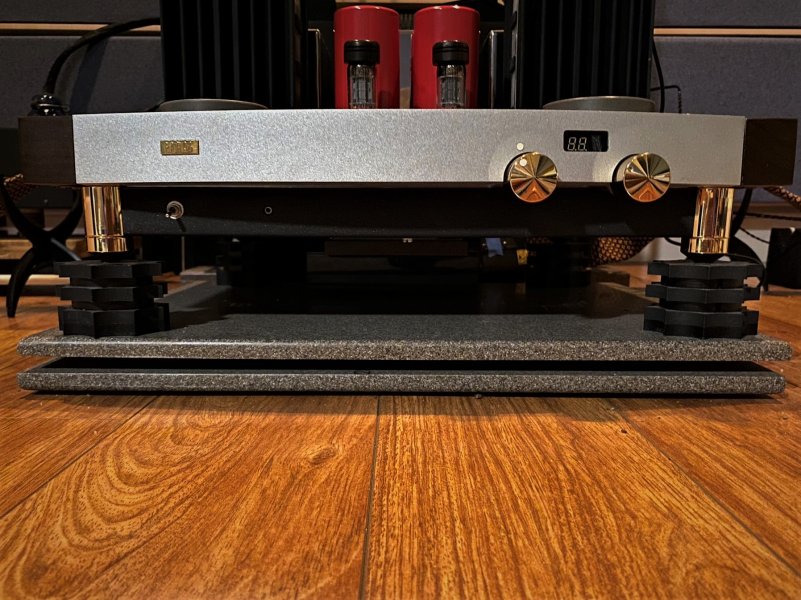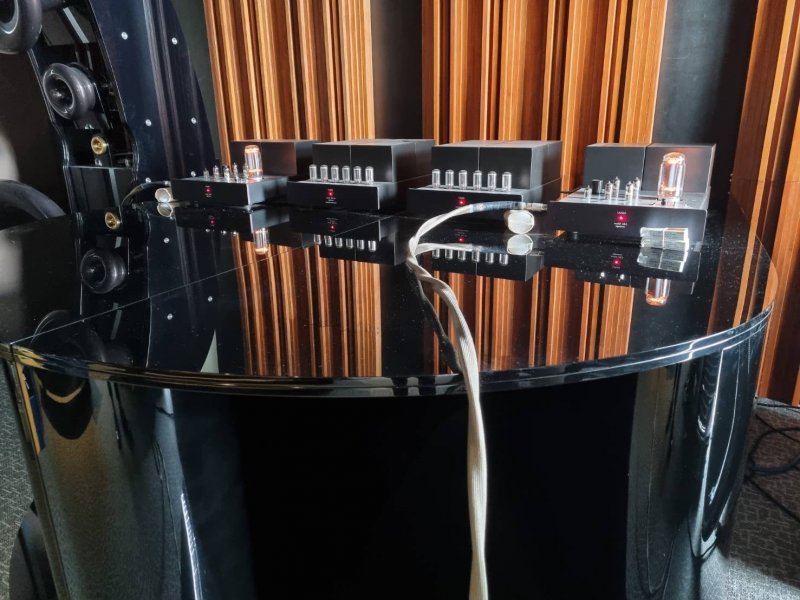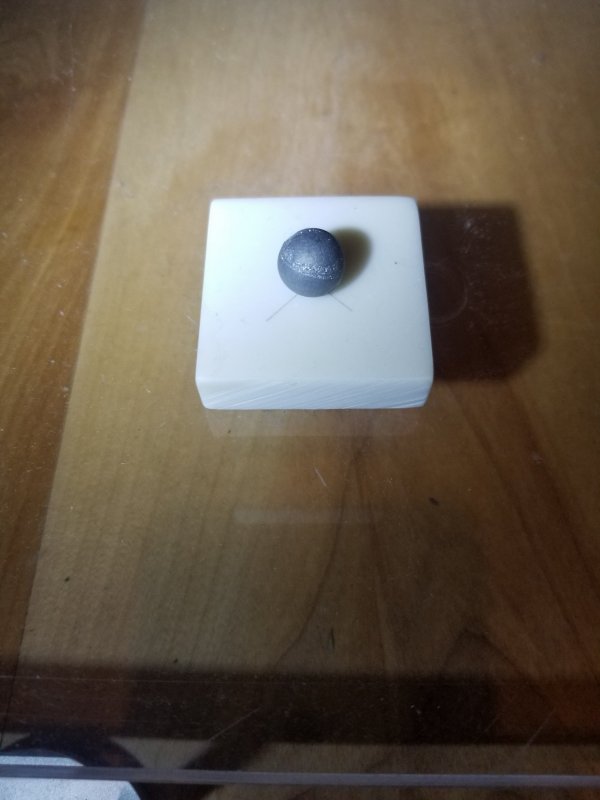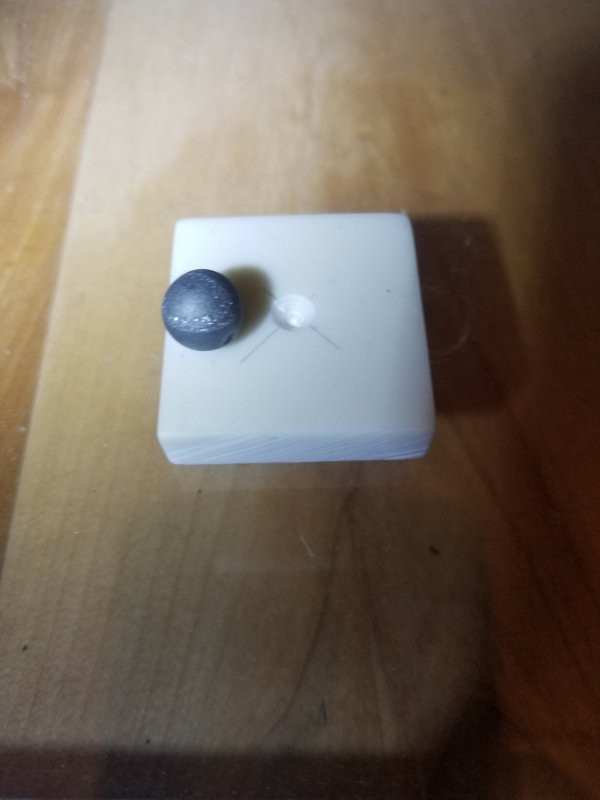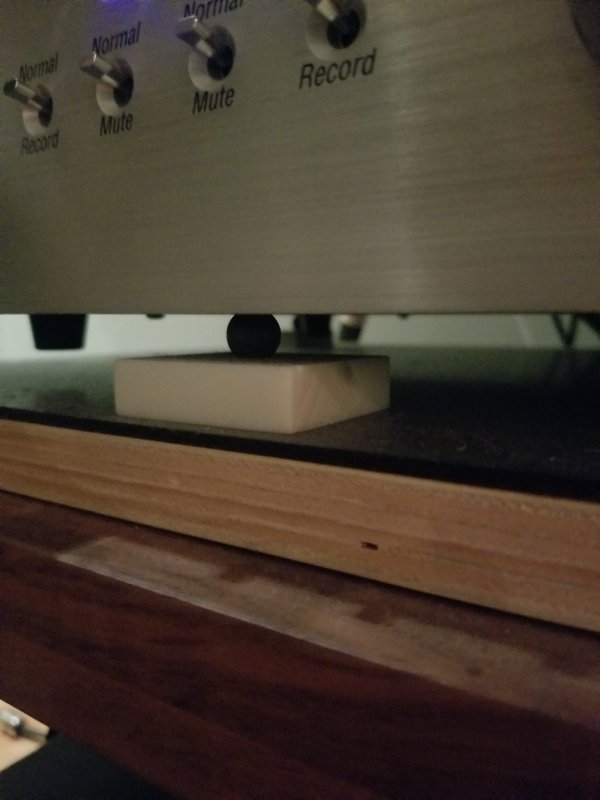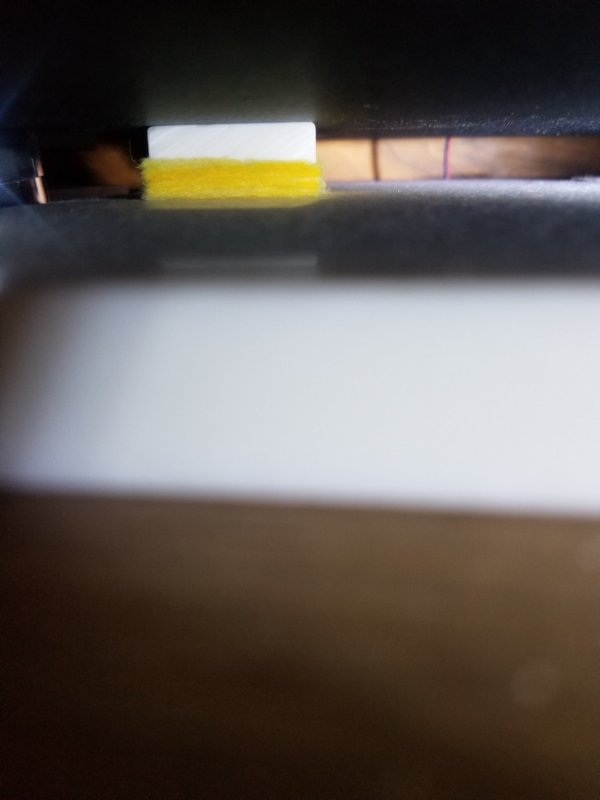Amp Isolation Recommendations
- Thread starter kroslos
- Start date
You are using an out of date browser. It may not display this or other websites correctly.
You should upgrade or use an alternative browser.
You should upgrade or use an alternative browser.
Elliot G.
Dealer - Bending Wave
I don't know where you are located however I just added some EVP's to my system and they are wonderful and cheap, especially before 12/31 as there is an increase coming. They work and I also suggest you try them under your speakers ( yes I am not crazy this is amazing) The prices for these go from about 45/105 dollars each this year. You can see them and what you need at avroomservice.comWow! So many responses and good suggestions for me to consider. Let me try to answer some of the questions that came across....
1) Regarding what I'm hoping to achieve, my system sounds great as it is. Wonderfully warm, articulate, great soundstage, but (and I qualify this because all of us are searching for some degree of "improvement"), I would like a bit more "immediacy", and sometimes, but not always, things can sound a bit veiled.
2) My amps are currently sitting on a very solid wood equipment rack (I'll post a picture below that shows my room). The feet on the amps are the original feet that came with the amps; so I have not done anything else to couple, or decouple, them.
3) 99% of my listening is vinyl and I'm quite happy with my setup of my vinyl front end. I have my turntable sitting on a metal (spiked) turntable rack, with a 4" Boos butcher block suspended on Nordost Sort Kone AC's.
4) I'd like to avoid "the rabbit hole" if at all possible. That is why I was hoping for a relatively inexpensive option that I'd be happy with the end results.
Thanks again for all the replies and suggestions!
After having tried several bases under my Air Tight 211 monos, I used HRS M3x platforms and wood between the amps original feets and the M3x.
Corian is acoustically dead - it does not resonate or transmit vibration. I use two 1/2" thick Corian boards with Herbie's Audio Lab "Tenderfeet" in between them to isolate my 90 lb. Pathos TT from the floor, and custom (to accept the amp's built in spikes) Marigo Mystery feet between the amp and the Corian boards to drain internally generated resonances. I put heavy duty felt discs on the bottom so I can easily slide the amp when necessary.I have a pair of AirTight ATM-2's that I've mono'ed and I'm looking for some suggestions/recommendations on isolation - inexpensive please. I really don't know if isolating my Amps will make any difference/improvement (comments welcome....); however, I'd like to give it a try if I can find something that is relatively effective and reasonably priced.
Thanks!
Kyle
Attachments
Last edited:
Symposium Ultra Pro Amp StandI have a pair of AirTight ATM-2's that I've mono'ed and I'm looking for some suggestions/recommendations on isolation - inexpensive please. I really don't know if isolating my Amps will make any difference/improvement (comments welcome....); however, I'd like to give it a try if I can find something that is relatively effective and reasonably priced.
Thanks!
Kyle
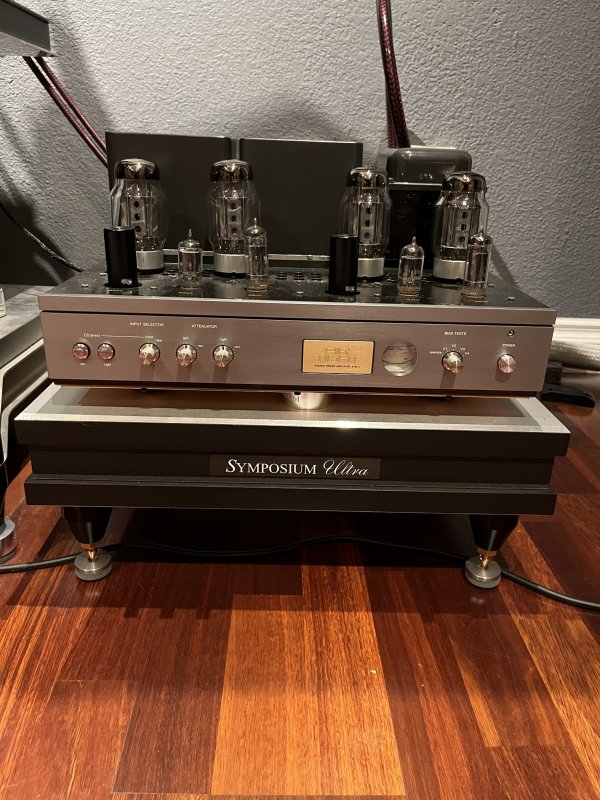
It may go against intuition, but a "dead" substrate is almost never the right choice when the component sets directly on it, IME. Steel or granite over corian or plywood for best results. Using a coupling device like the symposium couplers in @miniguy 's Air Tight pic does change that equation; almost reversing it. Again, going against intuition.
how serious are you about isolation? i have both my dart 468 amps on Takio Tana active systems. which is a combo of a Herzan TS-140 + a custom linear power supply.
i can turn these active devices on and off and the soundstage noticeably collapses and the level of micro-dynamics changes. how relevant is my feedback? i have a concrete floor and push things with lots of dynamics. not all gear equally 'like' active, but electronics seem to be pretty positive with it.
btw; my amps also have a built in suspension system for the power supplies, yet the active is still a step up. i've also talked about suspending my speaker cables and interconnects too. which is a recent thing for me, and likely make more differences with active than passive.
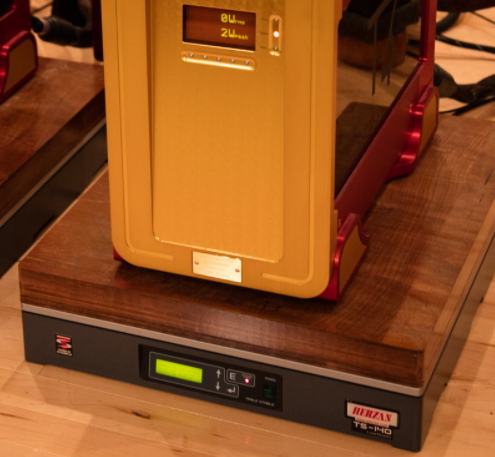
i can turn these active devices on and off and the soundstage noticeably collapses and the level of micro-dynamics changes. how relevant is my feedback? i have a concrete floor and push things with lots of dynamics. not all gear equally 'like' active, but electronics seem to be pretty positive with it.
btw; my amps also have a built in suspension system for the power supplies, yet the active is still a step up. i've also talked about suspending my speaker cables and interconnects too. which is a recent thing for me, and likely make more differences with active than passive.

Last edited:
That could be - I’ve never put a component on Corian without some type of isolation feet in between. However a quick "google" reveals that Corian is used for high quality sprung isolation platforms (e.g., Vayta), turntable plinths (e.g., PTP Audio), and speaker cabinets (e.g., Hoffner Audio, Prime Loudspeakers, Reference 3A, etc.) presumably based on more than "intuition".It may go against intuition, but a "dead" substrate is almost never the right choice when the component sets directly on it, IME. Steel or granite over corian or plywood for best results. Using a coupling device like the symposium couplers in @miniguy 's Air Tight pic does change that equation; almost reversing it. Again, going against intuition.
Last edited:
That could be - I’ve never put a component on Corian without some type of isolation feet in between. However a quick "google" reveals that Corian is used for high quality sprung isolation platforms (e.g., Vayta), turntable plinths (e.g., PTP Audio), and speaker cabinets (e.g., Hoffner Audio, Prime Loudspeakers, Reference 3A, etc.) presumably based on more than "intuition".
Depends on preference. Dead substrate equals dead sound in every instance for me. And that's not my preference nor based on intuition. So, after experimentation, I don't want isolation in the form of elastomers, whether it's Herbie gadgets , sorbathane, or what have you. Neither do I want bases or plinths or feet made from Corian, plywood, carbon fiber, etc. No comments on active isolation as I've never tried it.
Get some 1/2" corian and cut it into 1.5" x 1.5" squares.
Dimple the top.
Go to a bead shop or online and get Druzy Stone beads. Its almost like lava stone. Porus. Not very hard. When you flick it with your fingernail to ear its dull sounding. Not sharp and edgy like jade, cat eye or steel.
You also need to try the corian on a piece of 1" compressed fiberglass insulation.
I have found server and DAC are great on the fiberglass/corian. The preamps are better on the corian/bead.
You can also try a piece of Latvian Birch 9 ply plywood. Or a sheet of 1" acrylic. Or a sheet of 1/2" corian. Your stand is already dense. You could just try the feet. They cost me about $2 each to make.
Dimple the top.
Go to a bead shop or online and get Druzy Stone beads. Its almost like lava stone. Porus. Not very hard. When you flick it with your fingernail to ear its dull sounding. Not sharp and edgy like jade, cat eye or steel.
You also need to try the corian on a piece of 1" compressed fiberglass insulation.
I have found server and DAC are great on the fiberglass/corian. The preamps are better on the corian/bead.
You can also try a piece of Latvian Birch 9 ply plywood. Or a sheet of 1" acrylic. Or a sheet of 1/2" corian. Your stand is already dense. You could just try the feet. They cost me about $2 each to make.
Attachments
After years of experimentation I have found Corian to be sonically neutral which makes it a good base for draining or tuning feet. It stops the transfer of resonance/vibration without adding or subtracting anything of its own. Very happy with the setup.Depends on preference. Dead substrate equals dead sound in every instance for me. And that's not my preference nor based on intuition. So, after experimentation, I don't want isolation in the form of elastomers, whether it's Herbie gadgets , sorbathane, or what have you. Neither do I want bases or plinths or feet made from Corian, plywood, carbon fiber, etc. No comments on active isolation as I've never tried it.
It'd be worth trying a steel plate. 1" thick. To see the difference.After years of experimentation I have found Corian to be sonically neutral which makes it a good base for draining or tuning feet. It stops the transfer of resonance/vibration without adding or subtracting anything of its own. Very happy with the setup.
Wouldn't expect there to be much if any audible difference with the Marigo Mystery Feet (potent isolators as well as resonance drainers) between steel plate and amp. But if I used tuning spike receptacles (e.g., Harmonix, Yamamoto, etc.) I would expect the steel to ring/resonate to some extent which might have a sonic impact however slight.It'd be worth trying a steel plate. 1" thick. To see the difference.
You wouldn't use any of that other stuff. Set the component on the steel plate, and place either thin felt or some small O-rings between the plate and the shelf or floor.
You wouldn't use any of that other stuff. Set the component on the steel plate, and place either thin felt or some small O-rings between the plate and the shelf or floor.
I have found that the thickness of the plate, the type of steel, the size of the O-rings, and their number and location can all make a difference. The key is to experiment and listen until you find the combination that sounds right.
How many types of steel have you used and what were they?I have found that the thickness of the plate, the type of steel, the size of the O-rings, and their number and location can all make a difference. The key is to experiment and listen until you find the combination that sounds right.
Can't - the Pathos TT has integral spike feet - you have to use some sort of spike cup. Ron Hedrich at Marigo Labs customized a set of Mystery Feet for me to take the Pathos amp's spikes. Again - happy with what I'm using - no motivation to try a steel plate.You wouldn't use any of that other stuff. Set the component on the steel plate, and place either thin felt or some small O-rings between the plate and the shelf or floor.
Last edited:
How many types of steel have you used and what were they?
Hello Brian, Here is a list of the different steel plates I've tried under my gear:
1. steel, 3/4" X 20" X 36", Kinetic systems ballast plate, unknown steel type
2. steel, 7/8" X 20" X 28", Kinetic systems ballast plate, unknown steel type
3. A36, 1" X 20 X 24", scrap from metal shop, painted by me.
4. #304 Stainless Steel, 1" X 14" X 18", sanded, polished finish by me.
5. #304 Stainless Steel, 2" X 15" X 17.5", sanded, polished finish by me.
6. #304 Stainless Steel, 2" X 15" X 8.5", sanded, polished finish by me.
I placed my SME turntable and Pass amps on all of the thinner steel plates and they all sounded different. I switched back and forth during my experiments. The plates from Kinetic systems were highly damped, while the A36 plate I made rang a lot. The #304 stainless that I now use for the Lamm gear are somewhere in between.
Size and proportions matter too. I have two different sized 2" #304 SS for my TT motor and main unit. They have a different number of supports/dampers under each. The supports/dampers under the 1" #304 SS plates for my electronics are different too. They all ring differently, so they need different amounts of dampening and tuning. The important thing is that the steel provides mass. You can then fine-tune the sound based on the type and dimension of steel you use.
I think we discussed using natural felt under the plates. I did not find that very effective, but it did work better on top under the stock component footers.
Last edited:
Similar threads
- Replies
- 54
- Views
- 7K
- Replies
- 0
- Views
- 1K
- Replies
- 9
- Views
- 1K
- Replies
- 4
- Views
- 2K
| Steve Williams Site Founder | Site Owner | Administrator | Ron Resnick Site Owner | Administrator | Julian (The Fixer) Website Build | Marketing Managersing |








